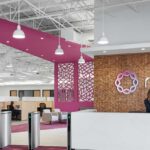
Students need different atmospheres for studying, hanging out, and grabbing a bite. It’s only natural that colleges and universities would benefit from “intelligent” educational interior design.
Residence halls set the tone for any education interior design space.
Attracting Freshmen
When it comes to attracting freshmen, the residence hall plays a significant role. Along with libraries, technology, sports facilities, and classrooms, residential facilities have become one the most influential factors in a student’s decision to attend. A key component of residence halls in education interior design is blurring the lines between living and learning creates opportunities for communities to emerge that expand learning and enrich social interactions.
Adaptability in education interior design
Adaptable residence halls might include living space for faculty and students, faculty offices, classrooms, and areas for academic advisors, tutoring, small group study, library space, and activities. Students come to campus with their own computers, printers, gaming systems, TVs, MP3 devices, cell phones, printers, and other “essentials” that they have integrated into their lives.

Healthful and Resourceful
Residence hall living/learning spaces should comfortably fit the people who occupy them and sustain their well-being. To create these healthful spaces, colleges and universities are applying what is known about the effect of space on the mind and the body. In any education interior design setting – students are asking for more than just technology. Laundry facilities, air conditioning, and security systems are also requirements today. Fitness rooms, satellite dining facilities, coffee shops, and convenience stores are routinely considered for new construction projects.
Let intelligent interiors provide you with a plan to design your new educational space (or revamp the existing one). We can give you all the options, expertise, and resources to get it done.



Leave a Reply